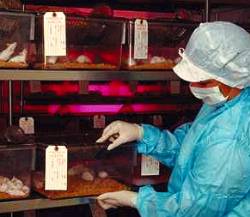Home Page
The latest articles, features and news.


All About...


Sponsored Links


Discussion Forums




Pecker Provisions


Condoms, lubes, pumps, stretchers, exercises, supplements, sports underwear and more.

Firefly Talks Dicks


Words of feminine wisdom about men's problems.

|
| | |
|

8 November 2004
Sperm Stem Cells Grown In Lab
by George Atkinson  Researchers working with mice have succeeded in growing sperm progenitor cells in laboratory culture. The researchers transplanted the cells into infertile mice, which were then able to produce sperm and father offspring that were genetically related to the donor mice. Their research appears in an upcoming issue of Proceedings of the National Academy of Sciences. "This advance opens up an exciting range of possibilities for future research, from developing new treatments for male infertility to enhancing the survival of endangered species," said Duane Alexander of the National Institute of Child Health and Human Development.
Researchers working with mice have succeeded in growing sperm progenitor cells in laboratory culture. The researchers transplanted the cells into infertile mice, which were then able to produce sperm and father offspring that were genetically related to the donor mice. Their research appears in an upcoming issue of Proceedings of the National Academy of Sciences. "This advance opens up an exciting range of possibilities for future research, from developing new treatments for male infertility to enhancing the survival of endangered species," said Duane Alexander of the National Institute of Child Health and Human Development. Led by Hiroshi Kubota, the team of researchers from the University of Pennsylvania School of Veterinary Medicine succeeded in developing the culture medium containing the precise combination of cellular growth factors needed for the cells to reproduce themselves outside the body. Known as spermatogonial stem cells, the cells are incapable of fertilizing egg cells but give rise to cells that develop into sperm. "This finding is likely to be applicable to humans," explained the study's senior author, Ralph L. Brinster. He said that the same growth factors needed to culture the mouse stem cells would likely foster the growth of human spermatogonial cells as well as the cells of other mammals. Currently, males who undergo chemotherapy that renders them infertile can store their semen so that it can be used at a later date, should they wish to father children. However, this approach has a less than 50 percent success rate. Boys who are too young to provide a semen sample but who also need such chemotherapy treatments could also be helped by the new technique. Their spermatogonial stem cells could be cultured to increase their numbers, frozen, and reimplanted at a later date, restoring their fertility.
|
|